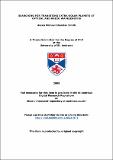Files in this item
Searching for transiting extra-solar planets at optical and radio wavelengths
Item metadata
| dc.contributor.advisor | Cameron, A. C. | |
| dc.contributor.author | Smith, Alexis Michael Sheridan | |
| dc.coverage.spatial | 141 | en_US |
| dc.date.accessioned | 2010-04-12T10:12:51Z | |
| dc.date.available | 2010-04-12T10:12:51Z | |
| dc.date.issued | 2009-11-30 | |
| dc.identifier.uri | https://hdl.handle.net/10023/871 | |
| dc.description.abstract | This thesis is concerned with various aspects of the detection and characterisation of transiting extra-solar planets. The noise properties of photometric data from SuperWASP, a wide-field survey instrument designed to detect exoplanets, are investigated. There has been a large shortfall in the number of planets such transit surveys have detected, compared to previous predictions of the planet catch. It has been suggested that correlated, or red, noise in the photometry is responsible for this; here it is confirmed that red noise is present in the SuperWASP photometry, and its effects on planet discovery are quantified. Examples are given of follow-up photometry of candidate transiting planets, confirming that modestly-sized telescopes can rule out some candidates photometrically. A Markov-chain Monte Carlo code is developed to fit transit lightcurves and determine the depth of such lightcurves in different passbands. Tests of this code with transit data of WASP-3 b are reported. The results of a search for additional transiting planets in known transiting planetary systems are presented. SuperWASP photometry of 24 such systems is searched for additional transits. No further planets are discovered, but a strong periodic signal is detected in the photometry of WASP-10. This is ascribed to stellar rotational variation, the period of which is determined to be 11.91 ± 0.05 days. Monte Carlo modelling is performed to quantify the ability of SuperWASP to detect additional transiting planets; it is determined that there is a good (> 50 per cent) chance of detecting additional, Saturn-sized planets in P ~ 10 day orbits. Finally, the first-ever attempt to detect the secondary eclipse of a transiting extra-solar planet at radio wavelengths is made. Although no eclipse is conclusively detected, upper limits to the flux density from HD 189733 b are established, and compared to theoretical predictions of the flux due to electron-cyclotron maser emission. | en_US |
| dc.language.iso | en | en_US |
| dc.publisher | University of St Andrews | |
| dc.subject | Astronomy | en_US |
| dc.subject | Astrophysics | en_US |
| dc.subject | Planet | en_US |
| dc.subject | Exoplanet | en_US |
| dc.subject | Extra-solar planet | en_US |
| dc.subject | Star | en_US |
| dc.subject | Stellar | en_US |
| dc.subject | Photometry | en_US |
| dc.subject | Star-planet interaction | en_US |
| dc.subject | WASP | en_US |
| dc.subject | SuperWASP | en_US |
| dc.subject.lcsh | Extrasolar planets--Detection | en |
| dc.subject.lcsh | Imaging systems in astronomy | en |
| dc.subject.lcsh | Transits | en |
| dc.subject.lcsh | QB820.S65 | |
| dc.title | Searching for transiting extra-solar planets at optical and radio wavelengths | en_US |
| dc.type | Thesis | en_US |
| dc.type.qualificationlevel | Doctoral | en_US |
| dc.type.qualificationname | PhD Doctor of Philosophy | en_US |
| dc.publisher.institution | The University of St Andrews | en_US |
This item appears in the following Collection(s)
Items in the St Andrews Research Repository are protected by copyright, with all rights reserved, unless otherwise indicated.

